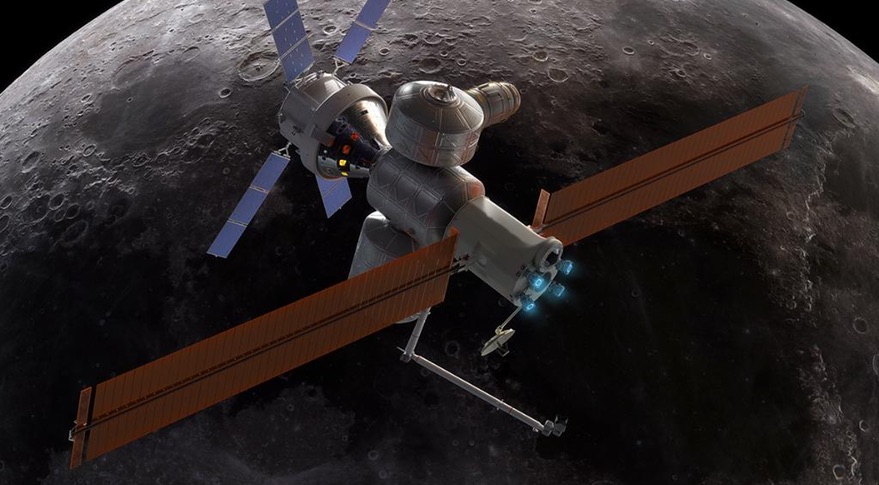Deep Space Gateway Key Part of Updated Exploration RoadmapSpace.com
By Debra Werner, SpaceNews | December 2, 2017 07:40am ET
 "The Deep Space Gateway is a concept for government-led exploration endeavors,: Kathy Laurini, NASA senior adviser for exploration and space operations, said during a Global Exploration Roadmap community workshop at the NASA Ames Research Center Nov. 29. "It is a commitment to being there. And because we are there, it will offer opportunities for commercial entities." Credit: Lockheed Martin
"The Deep Space Gateway is a concept for government-led exploration endeavors,: Kathy Laurini, NASA senior adviser for exploration and space operations, said during a Global Exploration Roadmap community workshop at the NASA Ames Research Center Nov. 29. "It is a commitment to being there. And because we are there, it will offer opportunities for commercial entities." Credit: Lockheed Martin SAN FRANCISCO – A new edition of an international space exploration planning document to be released early next year will offer an updated plan for human missions to the moon and Mars, emphasizing the role that NASA's proposed Deep Space Gateway could play.
In January, NASA and 14 international space agencies plan to publish their common goals for exploration, including an extended presence in low Earth orbit, a cislunar habitat, moon missions and eventual excursions to Mars, in an updated Global Exploration Roadmap being drafted by the International Space Exploration Coordination Group (ISECG).
Since NASA's first flight of its heavy-lift Space Launch System with an Orion capsule is scheduled for as soon as late 2019, it's time to decide "what we are going to do with these vehicles," Kathy Laurini, NASA senior adviser for exploration and space operations, said during a Global Exploration Roadmap community workshop at the NASA Ames Research Center Nov. 29. "We've been engaged with our international partners on how we'll use these to explore together."
ISECG, a voluntary organization whose members share non-binding plans and objectives, published its last Global Exploration Roadmap in 2013. ISECG members will use the new Roadmap to show domestic policymakers and funding agencies how specific programs will contribute to global endeavors, said Laurini, who also serves as ISECG chair.
NASA, for example, will point to the roadmap as it seeks funding and authorization for future SLS and Orion missions. NASA officials acknowledged, though, that the agency is waiting for confirmation of a new administrator and direction from the National Space Council. Future exploration plans will become clearer when the [Sleezebag] Administration and Congress weigh in on the agency's budget, said Mark Geyer, acting deputy associate administrator for NASA's Human Explorations and Operations Mission Directorate.
NASA also is seeking domestic and international support for its conceptual Deep Space Gateway. "We see an orbital platform as playing a vital and synergistic role with anything you do on the surface," said John Guidi, NASA advanced exploration systems deputy director. For instance, reusable landers could move astronauts to the Deep Space Gateway, which could also serve as a jumping off point for exploration of near Earth asteroids and Mars. "Cislunar orbit is the sweet spot. It's close enough to Earth and the moon but out of the gravity wells," Guidi said.
In the new Roadmap, ISECG will emphasize a shared commitment in the next 10 to 15 years to continue operations in low Earth orbit, where space agencies can conduct microgravity research and test life support systems for future exploration missions. Some of that work, though, may occur in new public or private space stations rather than the International Space Station.
The ISS partners have agreed to keep funding the space station through 2024. To date, NASA and its international partners have been able to maintain the aging space station with spare parts. However, older components, including the solar arrays, will need to be replaced by the end of the 2020s, said Robyn Gatens, deputy director of NASA's ISS Division. Even if the ISS partners do not make commitments to support it beyond 2024, the transition from space station to another platform should be gradual, Gatens added.
The new Roadmap lays out a three-phase plan. The starting point, Phase 0, is ongoing research and testing on ISS. During Phase 1 in the 2020s, international agencies would explore the lunar vicinity. In that timeframe, NASA would work with partners to construct the Deep Space Gateway, a crewed outpost with less than 10 percent of the habitable volume of ISS, and agencies would send robotic missions to the lunar surface and prepare for human lunar exploration. By Phase 2 in the 2030s, agencies would send exploration missions to orbit Mars.
Under current budget projections, NASA could launch one crewed SLS/Orion flight per year, with each Orion spending approximately 40 days at the Deep Space Gateway, Guidi said. Four SLS missions in the 2020s could assemble elements of the Deep Space Gateway, including its power and propulsion bus, habitat, logistics module and airlock, Guidi said.
ISECG shared its draft Roadmap to encourage companies, government agencies and academic organizations to offer comments. "The Deep Space Gateway is a concept for government-led exploration endeavors," Laurini said. "It is a commitment to being there. And because we are there, it will offer opportunities for commercial entities."
Those commercial opportunities, ISECG partners believe, include playing key roles in delivering cargo to the Deep Space Gateway, relaying communications from the lunar surface, sending instruments to the surface of the moon to support government investigations of volatile organic compounds and transporting cargo to the moon to support crews spending time there.
https://www.space.com/38963-deep-space-gateway-exploration-roadmap.html
![]() New SMAC quizzes available.
New SMAC quizzes available.![]() Chess is back.
Chess is back.![]() New SMAC quizzes available.
New SMAC quizzes available.![]() Chess is back.
Chess is back.